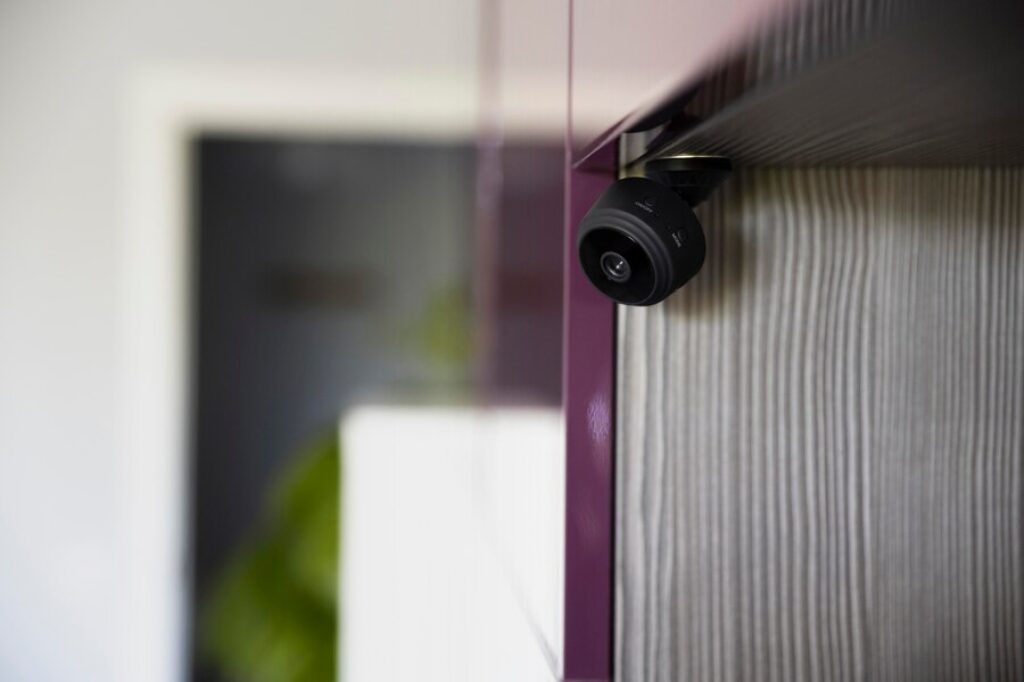
Even the inconspicuous egg tray is becoming connected to the web thanks to our unquenchable obsession with everything “smart.”
Smart fridges order your groceries for you, while smart thermostats pre-warm your house before you arrive.
However, the convenience and usability of Internet of Things (IoT) devices often overshadow the cybersecurity risks associated with them.
So today, rather than sing the praises of IoT, let’s explore common smart devices that are at risk of cyber attacks.
We’ll also cover how you can secure your home to ensure your IoT devices are secure and protected.
The 8 Most Common Iot Devices That Are Easily Hacked
#1. Laptops, Mobiles, And Tablets

85% of Americans now own a smartphone, according to Pew Research Center. Owners of smartphones, laptops, and tablets are at constant risk of data breaches, malware, and other cyber attacks.
Hackers love infiltrating mobiles and laptops, as most of your sensitive data is easily available. For most users, securing their mobile devices is only the first step towards total cybersecurity.
Effective cybersecurity requires premium software like antivirus, VPNs, and password vaults. Some “free” options are worth considering, but they usually make their money back by selling your data liberally.
#2. Video Game Consoles
Any house with a modern video game console also faces the risk of data breaches. Cyber attacks on consoles can occur due to outdated security protocols or even other users you play with online.
It’s all too common to get into a screaming match with an online opponent. While you don’t hold grudges, many other players do, taking out their frustrations on you. Attacks from video game consoles are often in the form of:
- Swatting: Disgruntled users report a fake bomb threat at the victim’s house, causing a raid by police.
- Identity theft: Data breaches and identity theft are common on consoles, likely due to account takeover.
- Ransomware: Hackers inject accounts with malware that can only be removed when the victim has paid a ransom.
#3. Home Voice Controllers
Home voice controllers like Google Home and Amazon Echo are all the rage. With simple spoken prompts, users can control music, plan their day, or search the web in seconds.
Yet, with all this convenience comes costly risks to your home security. In late 2022, security researcher Matt Kunze showed how easy it was to hack a smart speaker:
- Within proximity to the speaker, he remotely enabled the setup mode.
- Without any connection to the speaker’s WiFi, Kunze injected his own Google account and reconnected.
- The speaker reconnects to the victim’s WiFi, exposing the network to Kunze.
#4. Smart Doorbells
Smart doorbells and ring cameras have surged in popularity, but many experts warn users of their downfalls. Equipped with poor encryption (if at all) and a lack of security protocols, they’re easily hacked.
The thought of a stranger accessing your doorbell or seeing through your cameras sends a chill down your spine. However, the risks they pose to your network security are even more dire.
Smart doorbells are still relatively new and will only get better over time. For now, it might be worth avoiding this device if you can’t secure it.
Read Also: Diverse Horizons: The Impact Of Software Development Services Across Industries
#5. Home Security Cameras

You’ve probably got a few spread throughout the house, maybe even a couple in the kids’ rooms. Internet-connected security cameras are a go-to for people trying to secure their homes, but they may be achieving the opposite.
If you can check your camera feed remotely, it’s not hard to imagine a hacker can do the same. Worse yet, many newer models include speakers that have been hijacked by hackers.
In 2019, two Mississippi parents were shocked to find the security camera in their child’s room was hacked. The perpetrator began playing music through the device and, at one point, hurled racial slurs over a microphone.
#6. Smart locks
Similarly, various victims have found trouble securing their homes thanks to their smart locks. They’re convenient, mostly secure, and harder to pick than traditional locks, but they come with other security flaws.
While a lock-picker will have a much harder time breaking in, hackers could break the lock with an app. Just like other unsecured smart devices, smart locks also pose a threat to the safety of your network. For the best property protection solutions and expert insights, explore our insurance review page to safeguard your home effectively.
Smart locks need to be updated constantly to ensure any security flaws or backdoors are sealed shut.
#7. Internet-Connected Light Bulbs
Let’s face it — being able to turn your lights on or off over an app is awesome. However, products like Philip’s Hue aren’t very secure and highly regarded as a cybersecurity risk.
These bulbs gained controversy in 2018 when Eyal Ronen showed how they can be controlled wirelessly with an “IoT worm.” In a video, he flies a drone close to an office building and begins to manipulate their smart light bulbs.
Although it was only for research, this experiment shows how smart bulbs can represent a massive threat to cybersecurity.
#8. Air Quality Index (AQI) machines
Air quality worldwide has been dropping due to pollution and various other factors. Consequently, internet-connected AQI machines are becoming highly sought-after and recommended for personal health.
Yet, as the product is more closely related to health than cybersecurity, the in-built protections are lacking. Most keep records of your AQI and require a constant connection to the internet.
The weakest point of entry is often the most exploited. So, until IoT AQI machines are improved, it’s safest to trust AQI devices that don’t require the internet.
Ensuring The Safety Of Your Smart Home

Before you start freaking out because you own half of the devices on this list, let’s briefly cover IoT cybersecurity. Luckily, you only need to consider two things when securing your IoT devices:
- Network security: Start with securing your network. Antivirus, strong passwords, and firewalls are a minimum. For full network encryption, you should install a VPN on all devices and even your router — read about this here.
- Embedded security: Next, you need to identify and improve the in-built security of your IoT devices. This means installing firmware updates and perhaps choosing to disconnect a device that can’t be secured.
Even with these safeguards in place, it’s important never to bring your IoT devices to work. Corporate networks are already major targets, and unsecured IoT devices give hackers easy passage inside.
Conclusion
A smart home doesn’t need to be an unsafe home. IoT devices make our lives easier but also open our doors to unwanted cyber intruders.
Unless you secure your network and IoT devices, you too might hear a strange voice coming from your security cameras…
More Resources:






